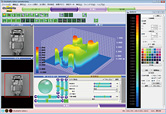
A Handy and Reliable Digital Microscope "SuttlePix."

Atsushi Takeuchi
Project Manager/Mechanical Engineer
Instruments Company
- How were the development process and the new product concept handled?
Mr. Takeuchi: First of all, we established a digital microscope research team in December 2007. We conducted intensive market research for four months. As a result, we found out that many users desired to have "Easy to operate," "All-in-one from shooting to measurement," and "mobility" features. The most desired feature was mobility. Conventional microscopes generally consist of a wired camera and monitor and weigh about 10 kg. They were not suitable for moving around. Then, we started a formal project with a new digital microscope project, "Develop a brand new handy and reliable microscope."
After we finalized the concept, we designed a new digital microscope body. Normally, we design a product's outlook after fixing the lens and mechanical functions. However, we felt that if we developed the lens and mechanical functions first, then we would risk not achieving the development of a handy microscope. We took this approach to remain true to our original concept. Secondly, we spent a year on necessary technology research of the lens, mechanics research and prototype developments. We spent another two years on production engineering for quality output. We are proud today to release this product to the market.
Listening to Real User Voices through The Intensive Market Researches
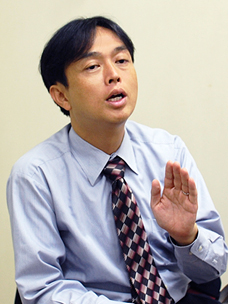
Koshiro Yokoyama
Instruments Company
- How did you conduct market research?
Mr. Yokoyama: We conducted three major market research projects. For the first research project, we visited users who predominately use a digital microscope rather than a conventional microscope. We asked how satisfied or dissatisfied they were and how they decided to purchase a digital microscope. In addition we asked a more in-depth question. For example how they decided to use a conventional microscope or a digital microscope if they have both of them. As a result, we were able to find underlying user needs which became a major part of the product's concept.
We analyzed the first user research then set a major direction and developed major specifications. When we formulated overall ideas of the product's specifications, we conducted the second user research. We validated the product's specifications such as zoom functions, lighting, software and application features with users on each actual usage scenes. We asked actual users to check if this new product meets their needs. We ended up adding some software functions to make the product more specific to the user's requirements.
The third research project focused on reconfirming the market needs of this new handy digital microscope. We visited potential customers to ask if they would like to use this product. We visited and talked to users as if we were selling this unfinished product. We visited many users in different industries and businesses, such as automobile, railway, steel, heavy industry, museum and quarantine departments. After the research, we had a better understanding on the user expectations towards the ShuttlePix and felt its potential to create broader business opportunities.
- How were the reactions on market research?
Mr. Takeuchi: We faced many harsh opinions and requirements from digital microscope users. It was a very hard process. On the other hand, those opinions encouraged us to produce a new digital microscope. During the third research project, we got a lot of good feedback and we were reassured that this product will be useful for many users. The results of the research were very valuable for us.
Universal Product Design - Easy Operation for female users
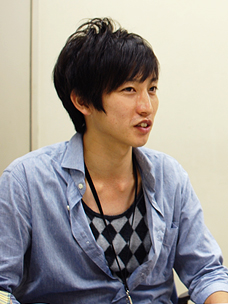
Tatsuya Uemachi
Designer
Imaging Company
- How did you approach designing SuttlePix?
Mr. Uemachi: We already know that there are many female users who are working in a production line and a quality assurance process. Therefore, we set a goal to realize a product design which was "easy to operate for female users." I have been involved from the planning phase and started thinking about a main structure which sets major usability. The main issues are how to reduce weight. In order to keep mobility, it is necessary to separate the head of a microscope from the equipped battery, LCD, operational parts and related circuit board and etc.
I decided to gather the heavier parts to a center for holding, so that it will result in feeling lighter than it actually is. I came up with "Gun-shaped design" after trying to have the best balance of weight and easier handling for female users. However, this design had a look of a weapon. Now I had to reconsider the design to have a white body color with a round shape to get rid of this weapon look. This round-shaped design created big challenges for the mechanical engineering side. I appreciated the team members' understanding of the aim of the product's design.
Product and brochure mock up to show the concept

- Concept brochure
- A concept brochure worked to share the same vision with everyone, so that the development team didn’t lose sight of the goals to achieve.

- Mock-up
- A detailed mock-up was working to put everybody on the same page and able to accelerate the development process.
- I heard that you created a concept brochure and mock up in the early stage of the design.
Mr. Takeuchi: I created a concept brochure and a mock-up at an early development stage. They represented concepts to keep consistency with the original concept and ideal specs during the product engineering processes. Usually it is difficult to have a common undestanding of the product concept for such an unique product as the ShuttlePix. The mock up helped the team members to have smoother communication and helped speed up the development. We used this mock-up so often, it became worn out. As a result, we could keep almost same specs with the original ideas.
- What did you think when you see the mock-up for the first time?
Mr. Kimura: I thought it was a very cool design. I wanted to make it possible.
Mr. Takeuchi: On first sight, I was wondering how we could install a 20x optical zoom function to such a small body. At the same time, in order to maintain mobility we couldn't make the body bigger. Honestly, I felt a lot of pressure to make it happen. I had to work on many issues to solve. I cleared issues one by one during the engineering process. When I showed the working prototype to team members, all of them were so delighted and saying, "Wow! It is working!"
Electric Engineering for Achieving Cordless Digital Microscope

Keita Masuda
Electrical Engineer
Instruments Company
- What was the most difficult aspect in the development process?
Mr. Masuda: I was thinking to make it cordless in order to achieve complete mobility. However, when I saw the mock-up, I was worried how I could make it cordless with such a tiny body. Actually, the cord's placement and connection of the head and stand without a cord were the most difficult parts.
- What was the design process to achieve an easy cordless connection?
Mr. Masuda: I was paying close attention to "Easy operation", which was one of the ShuttlePix concepts. It is easier to connect the head and stand with a cord from an engineering point of view. However, it creates another step to connect them and it would not look very good as well. So, I developed a new connection, simply dock a head to a stand. I have tried to apply smaller parts than on a normal microscope to achieve an easy operation concept.
We All Love The ShuttlePix Concept.
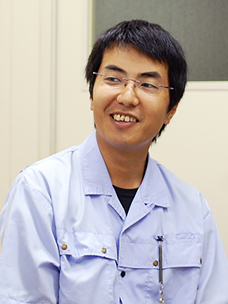
Ken Kawarabata
Mechanical Engineer
Instruments Company
- What kind of approach did you take to the mechanical engineering of this product?
Mr. Kawarabata: When I saw the mock-up, I thought it would be wonderful to realize this concept. I kept thinking about how I could make it happen. I dissembled my digital camera that had a high optical zoom and a music player with a thin circuit board to research how they were engineered.
- You were very enthusiastic to disassemble other electronics for your research.
Mr. Masuda: Mr. Kawarabata kept taking apart his electronic products one by one. He was a bit obsessed with it for a while. Thanks to his intensive research, we could come up with an idea for making ShuttlePix small.
(To Mr. Kawarabata) Didn't you feel any regret breaking your own electronics?
Mr. Kawarabata: No, I didn't. I never thought that I was wasting my stuff. I enjoyed thinking about how I would develop ShuttlePix while imagining I was a one of users.
Mr. Takeuchi: I think that he loves ShuttlePix the most among engineering team. We were joking he would be the first one to go buy it once it's out in the market.
"Unity" Was A Keyword of ShuttlePix

Isao Kimura
Software Engineer
Instruments Company
- How did you design user interfaces?
Mr. Kimura: ShuttlePix development keyword was "unity" for me. I decided to apply the menu panels and icons of COOLPIX, Nikon's digital cameras. Basically I united both the user interface of a digital camera and a microscope. Also, I could say in other words, ShuttlePix is the outcome of combining a microscope and a digital camera.
It was my first attempt to reuse COOLPIX's user interface. It's not simply copying, but adding ideas that are necessary in order to use digital and conventional microscopes. My contribution was to optimize the user interfaces for ShuttlePix users.
- What is a ShuttlePix's advantage of image processing?
Mr. Kimura: I think that Nikon's image quality, color, and clear image with less noise are very unique and a big advantage in comparison to other products. Also, I added our existing imaging technology such as an extended depth-of-focus, high dynamic range to enhance the image processing quality.
You Can View More Details with Nikon's Image Quality
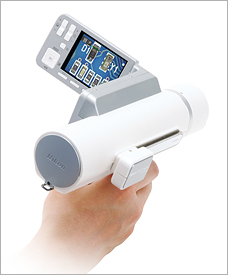
- What are the benefits for potential ShuttlePix users?
Mr. Takeuchi: You can observe new things with ShuttlePix, which you could not see with existing digital microscopes and conventional microscopes. Please use them at different scenes and occasions.
Mr. Yokoyama: You would not see digital microscopes in your daily life. However, I would love to hear a new way to use ShuttlePix.
- Lastly, what is your next goal in the development of digital microscopes?
Mr. Takeuchi: I think we still have many functions to apply to the ShuttlePix. I would love to hear opinions from users and customer's again to develop a better digital microscope.
-
Brochure
ShuttlePix Product Brochure in PDF format can be downloaded.
 Download ShuttlePix Brochure (PDF:2.02MB)
Download ShuttlePix Brochure (PDF:2.02MB)
Zoom Simulation
View a ShuttlePix zooming function.
-
ShuttlePix Editor Download (Free Dedicated Software)
Download ShuttlePix Editor*, the free dedicated software that provides useful features, such as simple measurement of sample objects and cross-section or 3D display of EDF images.
- *Compatible with Windows® XP and Windows® 7
- *Software can only be downloaded by users who have purchased ShuttlePix.
Questions related to products
- *Before you send your inquiry, please select "Digital Microscope" in a section of "product groups you are interested" in the inquiries page.
-
-
To view PDF documents, you need Adobe® Reader®.
-





